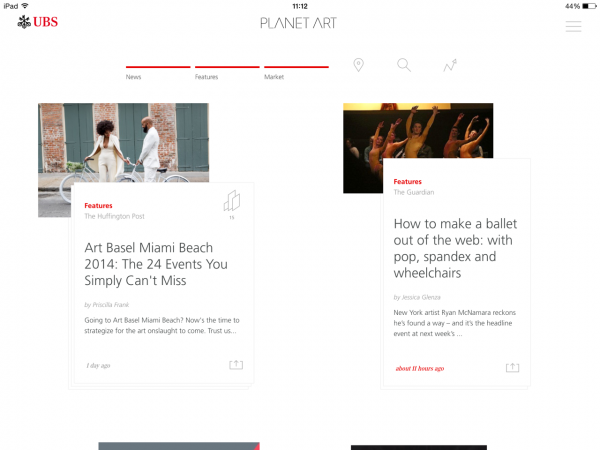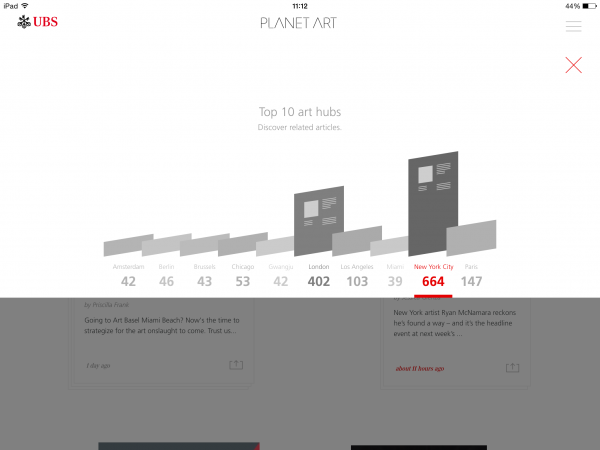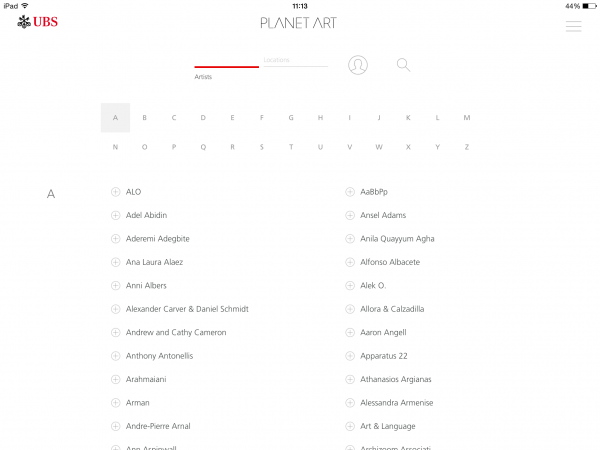Art & Exhibitions
Can This UBS Art App be The Bloomberg Terminal for the Art World?
UBS is trying its hand at art knowledge aggregation, but is it any good?

UBS is trying its hand at art knowledge aggregation, but is it any good?

Alexander Forbes

Swiss banking giant and Art Basel in Miami Beach sponsor UBS launched a new app on Monday. But it’s no thinly-veiled effort to flaunt their collection. Called Planet Art and designed by Germany’s Razorfish, the app seeks to cut through the glut of art publishing initiatives, filtering out the most essential news, features, and market analysis and presenting it all in a clean, pleasingly-designed layout on the iPad. See it as the curated arts RSS feeder you didn’t have to create yourself.
It’s an enticing prospect and one no doubt aimed at the iPad-clutching hordes of dealers and art advisers scurrying through art fair halls in Miami this week. Over the past week, according to the app’s built-in tracker, it has scanned over 400,000 keywords, 800 artists and locations, and nearly 600 articles for possible inclusion and ranking within its feeds. Users can customize those feeds based on artists and locations in which they are interested and filter for various genres of content. In theory, that should make the app a great on-the-go solution for art world intel akin to a light version of the popular Bloomberg Terminal service for the finance sector.
In practice, however, at least the initial beta comes up short. At launch, the focus of the app’s main content stream is appropriately placed on Art Basel, the obvious “trending” topic in the art world this week and the occasion for the app’s debut. But, the selection of content feels very mechanical and thus lacks a clear edit down of articles within that topic for relevancy. To be successful such an app needs to deliver key information in a glanceable manner.

UBS’s Planet Art App
Photo: Screenshot
The case is similar with Planet Art’s location-based filtering of content. Rather than creating a truly specific boil down of articles relevant to a certain city’s art scene, the app delivers what, despite their algorithms, appears to the user as more or less a keyword search through its content. The user is left with essentially any article that mentions the selected city in a way more similar to a Google News search than it is an indispensable industry tool.
This may change over time. UBS says Planet Art’s content delivery “uses machine learning to analyze thousands of articles online” and then indexes them based on a “data-led quality ranking to ensure you receive only the most relevant articles in your content stream.” In other words, it should get better at predicting what its users are interested in reading as they use it more.
However “smart” the app can get, however, one key decision will place it in the hands of enthusiasts rather than professionals. There is very little insight into which publications it scans other than what can be gleaned by a scroll through its feeds and zero ability to add new sources to those feeds or ignore others already in its boilerplate offer. It’s a very Web 1.0 tactic that could be the app’s undoing. Planet Art is not a one-stop-shop for art news. But the opportunity for it to develop into that means that, at the very least, I’ll wait for v2.0 before deleting.

UBS’s Planet Art App
Photo: Screenshot
Go to artnet News’s Art Basel in Miami page for the latest coverage, including:
“10 Ridiculous But True Rules For Navigating Art Basel in Miami Beach”
“9 Art World Pick-Up Lines Guaranteed (NOT) To Work At Art Basel in Miami Beach”
“15 Art Basel in Miami Beach Parties You’ll Never Get Into”
“Art World Sexy, Powerful, and Intimidating List: People You Need to Network With in Miami“